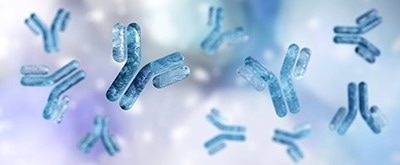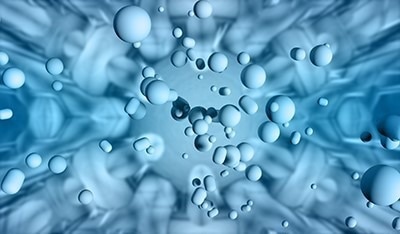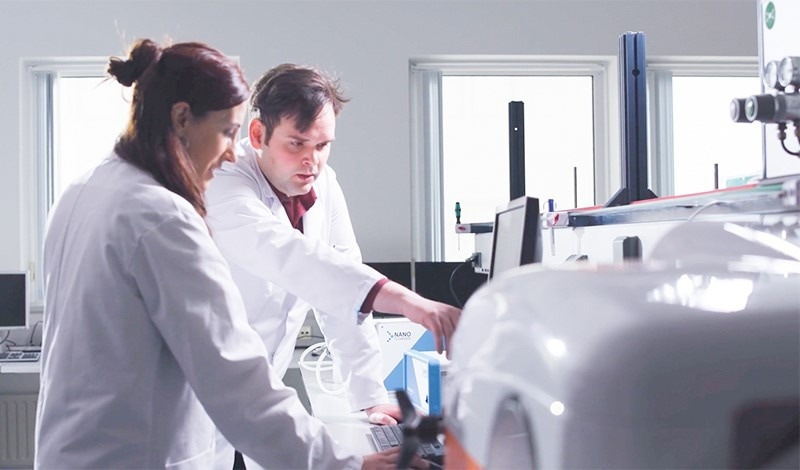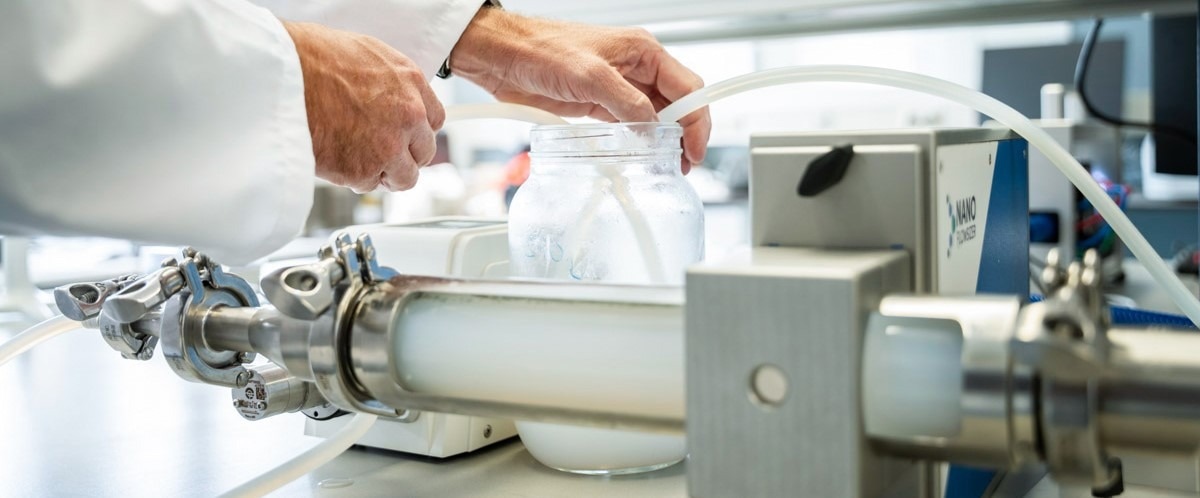Author: Bas Evers, Biopharmaceutical Application Specialist, InProcess-LSP

Image credit: InProcess-LSP
The use of nanoparticles has become increasingly popular in multiple industries, such as the chemical, food and pharmaceutical industries. Applications range from quantum dots in tv-screens to lipid nanoparticles (LNPs) in the recently developed mRNA covid-19 vaccines.
The unique efficacy of nanoparticles in general relies on its dimensional properties and it is therefore a key parameter to control. For example, the use of nanoparticles in LNPs in mRNA vaccines, are required to: assure safe, effective, and stable delivery of the active ingredients, allow optimal drug targeting and uptake, and reduce toxicity. With size being a key attribute to the success of nanoparticles, it is essential to accurately monitor and control it from manufacturing to end product. Therefore, the need for efficient and versatile nanoparticle size analysis methods is high, specifically for real-time performance monitoring during nanoparticle processing.

Image credit: InProcess-LSP
Dynamic Light Scattering
One of the most widely used nanoparticle size analysis methods is Dynamic Light Scattering (DLS). Although DLS based methods are known to lack high resolution, obtained particle size data by DLS provides valuable particle size data of the bulk material between 1 and 1000nm including polydispersity information. Although DLS can effectively be used for many different products and processes, it is not without limitations. A recently developed advanced nanoparticle size analysis method has emerged that is based on the same fundamentals as DLS, called Spatially Resolved Dynamic Light Scattering (SR-DLS). SR-DLS improves on multiple aspects in which conventional DLS has limitations. This article will discuss the differences and benefits of SR-DLS versus conventional DLS.
SR-DLS vs DLS
Higher turbidity range
Taking all possible nanosuspensions into account, a vast majority would need at least some dilution before conventional DLS would be able to accurately measure particle size characteristics. The concentration of particles, particle size and refractive index properties of the sample define the chance that laser light will be scattered more than once (multiple scattering) before it hits the detector, which results in inaccurate particle size results. By dilution the risk of multiple scattering can be mitigated, which is therefore a common approach for conventional DLS. A different approach is based on use of different optics to shorten the path length of the light through the sample, which will consequently lower the chance of multiple scattering.
SR-DLS offers a major benefit compared to DLS by being able to measure significantly more turbid samples without the need to dilute. Both DLS and SR-DLS require the scattered light to originate from single scattering effects in order to determine particle size. In contrast to conventional DLS, SR-DLS measures dynamic light scattering at multiple depths (pathlengths) in the sample and can identify at what depth in the sample multiple scattering occurs and automatically adjust the pathlength accordingly. Utilizing SR-DLS circumvents the need to dilute for even highly turbid samples where multiple scattering is normally the limiting factor for conventional DLS.

Image credit: InProcess-LSP
No sample handling
The use of SR-DLS allows you to directly measure even some of the most turbid suspension, without any sample handling. This offers substantial benefits in practice compared to DLS. Having to take samples has different practical, financial and qualitative downsides.
When sample handling is needed, the effort of taking and treating samples consistently involves a trained operator. This extra effort is inherently cost ineffective. In addition, any extra steps of sample handling introduce a risk for error, compared to a direct measurement of the product. Even when obtaining a correct particle size measurement reading from your analysis, it is crucial to determine whether your sample is representative to your untreated sample. In certain cases sample treatment can influence your sample material, for example by altered pH, or mechanical stress induced by handling. These risk factors are simply bypassed by SR-DLS due to elimination of any treatment. The ability to measure directly in a sample without any treatment also simplifies the analytical procedure, making SR-DLS more attractive for at-line analysis in a production area by operators.

Image credit: InProcess-LSP
Fast analysis
Analysis time of SR-DLS is considerably shorter compared to conventional DLS. A SR-DLS measurement takes less than 10 seconds to obtain similar particle size data as conventional DLS. Taking into account that no sample handling is required, SR-DLS is typically more attractive to screen a large number of sample in a shorter time.
The fast analysis of SR-DLS also allows you to monitor dynamic processes where particle size changes rapidly or where formulations are unstable. The time spent performing a dilution step, required when using conventional DLS, means you cannot monitor any particle size changes during this period, whereas in SR-DLS continuous and real-time particle size information is being obtained.

Image credit: InProcess-LSP
Non-destructive and non-invasive
The ability to measure nanosuspensions directly, without any treatment becomes even more attractive since SR-DLS measures non-invasively through glass. Samples in glass vials, syringes or other closed glass type containers can be measured without opening the sample or ‘touching’ the sample material.
The use of SR-DLS enables you to measure your suspension of interested directly in the vessel it is in, without direct contact with the suspension at all. For example, an end product contained in a syringe or vial can non-invasively be analysed. For stability testing for example, the same syringe or vial can therefore be analysed at different moments in time, which saves a significant number of stability samples and provides stability data of the same sample. Another example where directly measuring your sample without having to handle it is beneficial, is when working with hazardous material. Working with hazardous material may require specialized staff and preventative measures to safely handle sample treatment before being able to analyse the material.

Image credit: InProcess-LSP
Measuring in flow
One of the most unique features of SR-DLS compared to conventional DLS is the ability to measure flowing suspensions. Conventional DLS analysis requires a static sample since additional movement of the nanoparticles (due to flow) will be misinterpreted as a higher diffusion rate (and smaller particle size) of particles which is apparently not the case. Because of SR-DLS’ ability to measure at different depths in a suspension, flow profiles are obtained and extracted automatically at every measurement as long as the flow is laminary. This attribute of SR-DLS allows direct measurement in flowing suspension, from small-scale R&D set-ups up to large-scale manufacturing processes (up to 300-400 liters per hour). This unique feature of SR-DLS in combination with the ability to measure without sample treatment within 10 seconds makes SR-DLS an attractive PAT tool for continuous monitoring of nanoparticle processes.

Image credit: InProcess-LSP
Real time particle size analysis provides the possibility to adjust process parameters affecting nanoparticle size by real time feedback loops. Inline or online analysis by SR-DLS will increase efficiency by eliminating sampling procedures completely while providing real time information of the process. Also sample materials will be saved and costly downtime in production (for sampling and analysis) will no longer be required.
Final remarks
Although both DLS and SR-DLS are very versatile nanoparticle size analysis methods, SR-DLS improves on the existing capabilities of DLS by adding simplicity and efficiency to the analysis, due to its capability to measure non-invasively highly turbid suspensions without the need to dilute samples. For offline or at-line analysis SR-DLS may therefore become an attractive alternative for conventional DLS. Additionally, SR-DLS as PAT tool is uniquely capable of measuring flowing suspensions in real time, therefore opening the door to efficient monitoring and control of continuous manufacturing processes of nanoparticles.